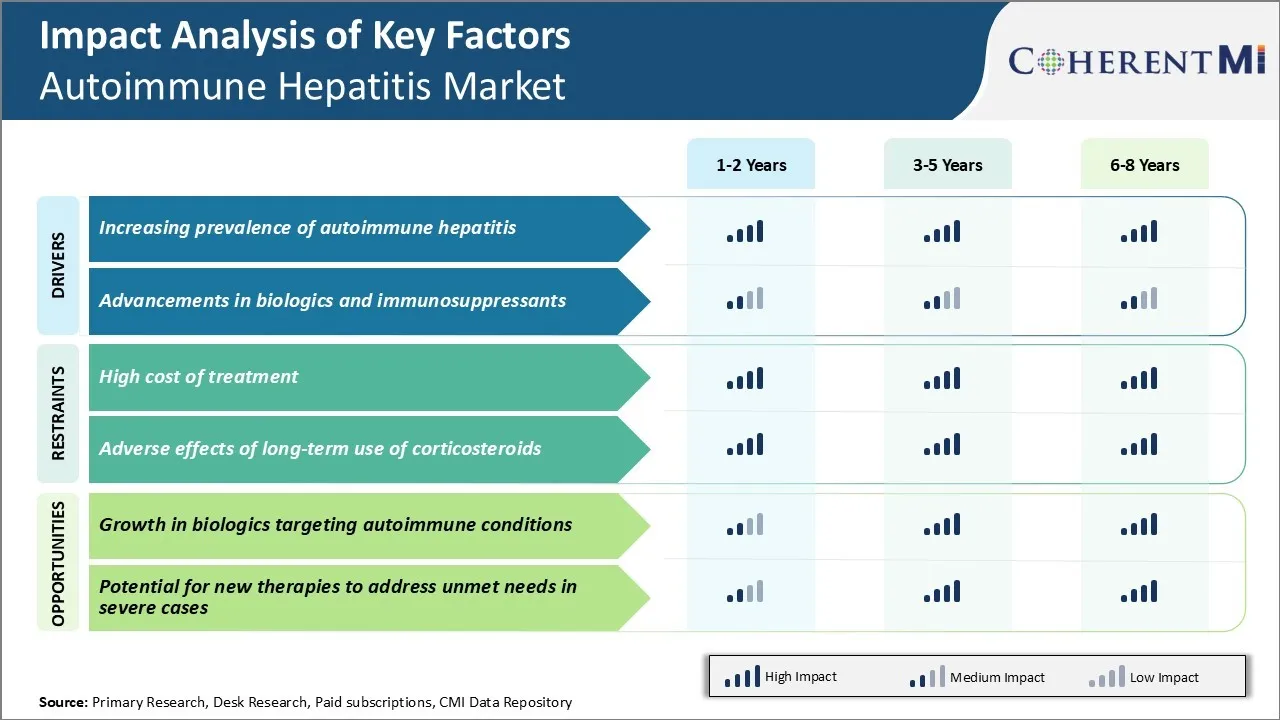Аутоиммунный гепатит рынок АНАЛИЗ РАЗМЕРОВ И ДОЛЕЙ - ТЕНДЕНЦИИ РОСТА И ПРОГНОЗЫ (2024 - 2031)
Аутоиммунный гепатит Рынок сегментирован по терапевтическим средствам (иммуносупрессивные препараты, кортикостероиды, биологические препараты), По нар....
Аутоиммунный гепатит рынок Тенденции
Рыночный драйвер - увеличение распространенности аутоиммунного гепатита
В последние годы на рынке аутоиммунных гепатитов наблюдается значительный рост из-за растущей распространенности заболевания среди населения мира. Согласно различным исследованиям, проведенным ведущими медицинскими учреждениями, в настоящее время около 2 миллионов человек во всем мире страдают от аутоиммунного гепатита. Возникновение этого хронического воспалительного заболевания чаще встречается у женщин по сравнению с мужчинами. Коэффициент распространенности между женщинами и мужчинами составляет около 3:1.
Географически развитые регионы, такие как Северная Америка и Западная Европа, за последние два десятилетия значительно выросли. Это может быть связано с улучшением диагностических возможностей и увеличением скрининга. Тем не менее, даже развивающиеся страны Азиатско-Тихоокеанского региона и Латинской Америки демонстрируют более высокие показатели из-за широкомасштабных изменений образа жизни. В педиатрической популяции также выявляется больше случаев, что требует эффективных вариантов лечения, подходящих для детей.
В целом, при неуклонном росте мирового населения и повышении воздействия на окружающую среду, ожидается, что распространенность аутоиммунного гепатита будет продолжать расти в долгосрочной перспективе. Эта тенденция к росту предоставляет значительные возможности для игроков на рынке аутоиммунного гепатита, удовлетворяя потребности в лечении растущей базы пациентов во всем мире.
Драйвер рынка - Достижения в области биологии и иммунодепрессантов
Ландшафт лечения аутоиммунного гепатита значительно изменился в последние годы с появлением новых классов лекарств. Традиционно кортикостероиды наряду с азатиоприном были основой лечения. Однако их использование было связано с несколькими побочными эффектами при длительном введении. Это обеспечило сильную филипу для разработки более безопасных и эффективных альтернатив лечения.
Аналогичным образом, недавние одобрения ингибиторов JAK представляют собой дополнительные варианты лечения. Блокируя преобразователь сигналов киназы януса и активатор пути транскрипции белка, они помогают контролировать печеночное воспаление и предотвращать вспышки. По сравнению с существующими вариантами они имеют более мягкие побочные эффекты и лучшую переносимость. Их однократное ежедневное пероральное дозирование также повышает соответствие лечению и удобство для пациентов.
Кроме того, новые иммунодепрессанты, ориентированные на селективные пути интерлейкина, показали эффективность в клинических испытаниях. Эти целевые агенты подавляют иммунный ответ более точно с меньшим вредом для других систем организма. Ожидается, что поток таких молекул трубопровода выйдет на рынок в ближайшие годы.
Таким образом, непрерывная эволюция биологических и целевых платформ синтетических лекарств значительно улучшила управление аутоиммунными гепатитами. Они устраняют предыдущие ограничения и расширяют индивидуализацию лечения. Это, в свою очередь, играет важную роль в укреплении траекторий роста рынка.

Вызов рынка - высокая стоимость лечения
Одной из основных проблем, с которыми сталкивается рынок аутоиммунного гепатита, является высокая стоимость доступных вариантов лечения. Аутоиммунный гепатит требует длительного лечения и лечения, что значительно увеличивает общую нагрузку на пациентов. Стандартное лечение первой линии включает иммунодепрессанты, такие как преднизон и азатиоприн, которые довольно эффективны, но также очень дороги. Затраты на эти препараты значительно возрастают в течение длительной терапии.
Кроме того, значительное число пациентов не реагируют адекватно на лечение первой линии или имеют побочные реакции. В таких случаях используются методы лечения второй линии, такие как будесонид, микофенолат мофетил или комбинированная терапия, которые имеют еще более высокие затраты. Финансовая токсичность долгосрочного лечения аутоиммунного гепатита создает серьезные проблемы с доступностью для многих пациентов. Это действует как основное препятствие для соблюдения и соблюдения режима лечения.
Высокие расходы на здравоохранение могут негативно повлиять на доступ к жизненно важным методам лечения для части населения. Решение вопросов, связанных с доступностью вариантов лечения аутоиммунного гепатита, является ключевой проблемой, которую необходимо решить, чтобы стимулировать рост на этом рынке.
Возможности рынка - рост биологических препаратов, нацеленных на аутоиммунные условия
Одной из основных возможностей на рынке аутоиммунного гепатита является повышенное внимание к разработке экономически эффективных биологических препаратов, которые нацелены на конкретные пути, участвующие в аутоиммунных заболеваниях. В настоящее время проводятся значительные исследования для понимания патогенеза аутоиммунного гепатита на молекулярном уровне для выявления новых лекарственных мишеней.
Несколько биотехнологических компаний и фармацевтических гигантов вкладывают значительные средства в разработку биологических препаратов, таких как моноклональные антитела, термоядерные белки и т. д., которые избирательно влияют на определенные цитокины, рецепторы клеточной поверхности или сигнальные молекулы, участвующие в возникновении аутоиммунного ответа. Эти варианты целевой терапии могут быть более эффективными, чем существующие неспецифические иммунодепрессанты с более низкими затратами на лечение.
Успешное развитие таких высокоточных биопрепаратов может нарушить ландшафт лечения аутоиммунного гепатита и создать широкие возможности для роста в будущем. Выход на рынок может помочь решить проблему ограничения высоких расходов на лечение аутоиммунного гепатита.